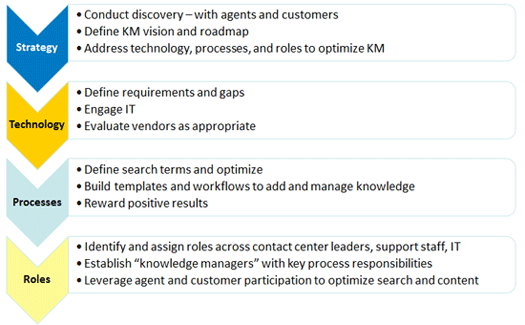 The concept of “Ready, Aim, Fire” applies as much to the challenge of KM as it does to hitting the bull’s eye with a bow-and-arrow or nailing a free throw in basketball. If you are serious about making a quantum improvement in your center’s knowledge management while spending resources wisely, you need to invest the time to do it right.
The concept of “Ready, Aim, Fire” applies as much to the challenge of KM as it does to hitting the bull’s eye with a bow-and-arrow or nailing a free throw in basketball. If you are serious about making a quantum improvement in your center’s knowledge management while spending resources wisely, you need to invest the time to do it right.
The “Ready” part of the equation calls for taking stock of where you stand with KM. It means identifying all of the repositories where you maintain relevant content as well as all of the available technologies to access them. You may be surprised by the number and diversity of resources – e.g., cheat sheets, binders, files in individual personal computers, file folders on the internal network, SharePoint directories, wikis, Customer Relationship Management (CRM) solutions, and (underutilized) KM applications.
Taking stock requires walking a mile in your reps’ shoes to see what resources they actually use, when they use them, and the processes through which they access the information. Observations, interviews, and focus groups are all good methods to use. If your customers tap knowledge through self-service (IVR, web, or other), you’ll want to do a similar discovery process walking in their shoes. These efforts identify hurdles that may crop up as you tackle knowledge-based initiatives.
Your strategy should contemplate the future state that you endeavor to create – i.e., the target toward which you’ll “Aim.” Ideally, your end state should support KM for all assisted service channels and customer self-service options. It should define the breadth and depth of content needed to support each role and channel as well as how each knowledge element will be accessed. It should contemplate a search function that delivers the proper content on every use, based on words and phrases the user would actually enter. And it should limit the number of content repositories to simplify knowledge administration and ensure consistent information delivery across all points of access.
When defining your strategy, consider your agents’ role in managing and maintaining the knowledge resource(s), in addition to the resources that will be assigned direct “knowledge management” responsibilities. For example, you need to provide a means for agents to rate existing content, contribute new content, and send up a flare when important content is missing or out-of-date. Similarly, you’ll need to assess the customer experience with KM via self-service and incorporate their feedback into your continuous improvement efforts as well. The processes you define and resources and time you assign to leverage KM technology will be critical to success.

With unlimited resources, you might have the luxury of taking aim at this all-encompassing target and fire. In the real world, we have resource limitations as well as the good sense to know that we might choke if we bite off too large a piece all at once! A carefully considered strategy keeps an eye on the long term target while crafting a roadmap that moves in the right direction sensibly and affordably.
